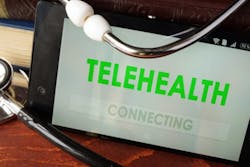U.S. Senators Brian Schatz (D-Hawai‘i), Roger Wicker (R-Miss.), Thad Cochran (R-Miss.), Ben Cardin (D-Md.), John Thune (R-S.D.), and Mark Warner (D-Va.) today introduced bipartisan legislation that would expand telehealth and remote patient monitoring (RPM) services in Medicare, toward the goal of cost savings and quality care.
Numerous studies on telehealth and RPM have shown benefits in quality care and cost savings, according to the bill’s authors.
Currently, there are restrictions on reimbursement for telehealth and RPM services under Medicare, such as patients may only be located at certain clinical sites or within certain rural areas and only Medicare-defined physicians and practitioners can provide telehealth services. In addition, store-and-forward technologies are currently only permitted in Alaska and Hawaii, and there are also limitations on covered codes as the Centers for Medicare & Medicaid Services (CMS) must define reimbursable telehealth codes.
The bill, titled the Creating Opportunities Now for Necessary and Effective Care Technologies (CONNECT) for Health Act of 2017, would build on the CONNECT for Health Act-inspired provisions in the CHRONIC Care Act, which expand the use of telehealth in accountable care organizations and Medicare Advantage, as well as for home dialysis patients and the evaluation of an acute stroke.
In addition, the bill would expand the use of RPM for certain patients with chronic conditions and increase telehealth and RPM services in community health centers and rural health clinics, Native American sites, and in global and bundled payments. Further, the bill aims to provide direct authority to the U.S. Department of Health and Human Services (HHS) Secretary to lift existing restrictions on telehealth when certain quality and cost-effectiveness criteria are met and would expand the use of tele-mental health.
According to a summary of the bill provided by Sen. Schatz, one of the goals for the CONNECT for Health Act includes lifting many of these restrictions while doing so in ways that expose Medicare to less financial risk, such as through capitated or set payment arrangements.
Sen. Schatz introduced the CONNECT for Health Act last February in the 114th Congress, as reported by Healthcare Informatics. New provisions of the bill in the 115th Congress include allowing telehealth and RPM in global/bundled payments, expanding telemental health and directs HHS to study the use of telehealth and RPM under all demonstration programs and pilots with a telehealth waiver.
“Telehealth is the future of health care. It expands access to care, lowers costs, and helps more people stay healthy,” Senator Schatz said in a statement. “Our bipartisan bill will help change the way patients get the care they need, improving the health care system for both patients and health care providers.”
The legislation has gained the support of more than 50 organizations, including ACT | The App Association, Alliance for Connected Care, the American Medical Association (AMA), the American Telemedicine Association, AMGA and the College of Healthcare Information Management Executives (CHIME).
Andrew W. Gurman, M.D., president of AMA, said in a statement, “This legislation would advance patient-centered care through strategic and validated telemedicine and remote-patient monitoring tools and modalities. Increasing Medicare coverage for these telemedicine services will help transform the next generation of health care delivery in ways that promote value and improved patient outcomes. The AMA looks forward to working to advance this legislation in the Congress.”
ACT | The App Association’s Connected Health Initiative (CHI) also publicly supported the Senate’s reintroduction of the legislation. In a statement, CHI Executive Director Morgan Reed issued the following statement: “The CONNECT for Health Act provides a carefully-crafted approach to begin helping countless American Medicare recipients realize the benefits of connected health technology. By lifting arduous limitations on the use of telehealth and empowering Medicare physicians to utilize innovative remote monitoring technologies, responsible and secure connected health solutions may be introduced more broadly throughout the continuum of care to improve patient health outcomes.
“We support the CONNECT for Health Act, and will work to address remaining issues in the path forward. CHI will continue to work to ensure the American healthcare environment is one in which innovative technologies, both available and in development, can reduce costs and improve healthcare for all Americans,” Reed stated.


